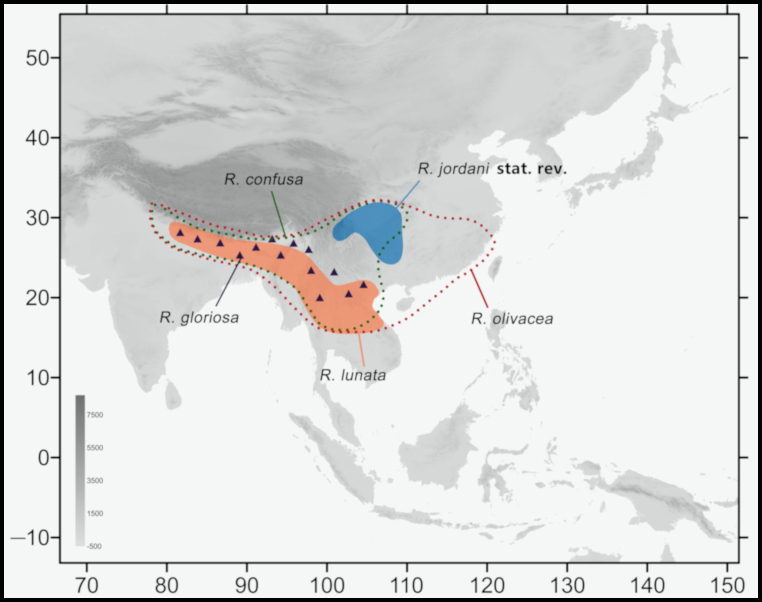


Chaerocampa [sic] lunata Rothschild, 1900, Novit. zool. 7: 274. Type locality: India, Assam [Meghalaya], Khasia Hills [Khasi Hills].
Synonyms. Chaerocampa lunata Rothschild, 1900.
Synonyms. Rhagastis lunata sikhimensis Rothschild & Jordan, 1903.
Synonyms. Rhagastis lunata gehleni Bender, 1942.
Synonyms. Rhagastis lunata yunnanaria Chu & Wang, 1980.
Synonyms. Rhagastis lunata yunnana Chu & Wang, 1983.
Wingspan: 72--86mm. Similar to Rhagastis olivacea, but ground colour yellow-brown. Forewing upperside with a characteristic bluish-white submarginal line formed of crescent-shaped marks the horns of which are directed basally. Both wings pinkish-red, with traces of ochreous ground colour distally. Black basal area of forewing reduced to a streak or patch behind the discal cell. Hindwing upperside black-brownish, with a well-defined orange-beige median band extending to Rs, indented at M2, and including a series of vein dots. Abdomen with orange patch laterally. Underside covered with rose and white hair. Labial palp segment 1 apical cavity not large but distinct; segment 2 not narrowed towards base. Antenna longer and thicker than in all other Rhagastis species except Rhagastis gloriosa (from which it differs in the lack of dark red bands on the forewing upperside); apical black scaling confined to the distal 2-6 segments. External row of spines on first protarsal segment simple, or irregularly doubled at base.
The male genitalia similar to that of Rhagastis jordani. Uncus longer. Sacculus much longer and obviously sharper than in Rhagastis jordani. Phallus thicker, anterior lobe of the process more curved and smoother (Jiang et al., 2024).
Unknown.
China: 12.vi (Yunnan); 1.vii (Yunnan).
OVUM: Unknown.
LARVA: Unknown.
PUPA: Unknown.
Larval hostplants. Unknown.
Unknown.
China: Yunnan (nr. Yingjiang, Xima County, 2080m; Yingjiang, 1007m; Pingbian Daweishan [Nature Reserve], 1500m; Gaoligong Shan; Changning Co., Songzhishanding, 2500m; Weibaoshan; Dulongjiang, 1980m); south Xizang/Tibet (Mutu, Namjagbarwa region, 2000m (Wang, 1988); Zhangmu, 2200m; Zayu, 1840m; Motuo/Metok/Mędog/Pemako, 2115m).
Nepal, Bhutan, northeastern India, Myanmar/Burma, Thailand, southwestern China, Laos (Xiengkhouang Province), Vietnam.

Map: Distribution of species of the olivacea group of the genus Rhagastis. The green dotted line indicates the range of R. confusa, the red dotted line indicates the range of R. olivacea, the blue patch indicates the range of R. jordani, the orange patch indicates the range of R. lunata, and purple triangles indicate the range of R. gloriosa. (© Jiang, Wang, Xu, Kitching, Huang, Hu & Xiao, 2024).
 Return to Sphingidae of the Eastern Palaearctic species list
Return to Sphingidae of the Eastern Palaearctic species list